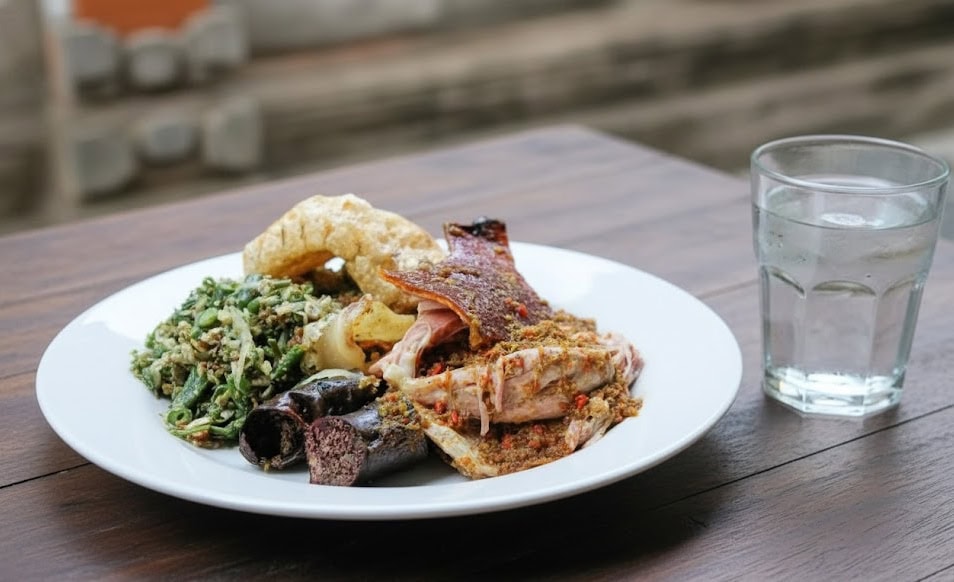In the vibrant culinary landscape of Bali, few dishes command as much reverence and widespread adoration as Babi Guling, the island’s iconic roasted suckling pig. More than just a meal, Babi Guling is a culinary institution, a dish deeply intertwined with Balinese culture, tradition, and celebration. Its crispy skin, succulent meat, and aromatic spices make it a must-try for any visitor to the Island of the Gods, offering a taste experience that is both rich in flavor and cultural significance.
A Dish Steeped in History and Tradition
The tradition of roasting pigs over coals in Bali dates back centuries, long before the arrival of modern culinary techniques. Early Austronesian settlers on the island introduced the practice, and with the subsequent spread of Hinduism, Babi Guling became an integral part of religious ceremonies and special occasions. For a long time, Babi Guling was primarily reserved for elaborate temple festivals (odalan), weddings, funerals (ngaben), and other significant community gatherings. It was a dish of communal feasting, symbolizing prosperity and gratitude.
Today, while still a centerpiece of Balinese ceremonies, Babi Guling has transitioned from an exclusive ceremonial dish to a widely available culinary delight. Numerous warungs (small, local eateries) and restaurants across the island specialize in serving this delicacy, making it accessible to both locals and tourists seeking an authentic taste of Bali.
The Art of Preparation: A Labor of Love
The creation of Babi Guling is a meticulous and time-consuming process, a true labor of love that requires skill, patience, and a deep understanding of traditional Balinese flavors. The star of the dish is a whole suckling pig, typically young and tender, which is carefully cleaned and prepared.
The Bumbu: Bali’s Flavorful Heart
At the core of Babi Guling’s distinctive taste is the bumbu Bali, a rich and aromatic spice paste. This complex blend typically includes a variety of fresh ingredients, pounded together to release their full flavors:
- Shallots and Garlic: The foundational aromatics.
- Turmeric: For its vibrant color and earthy notes.
- Galangal and Ginger: Providing pungent and spicy undertones.
- Lemongrass: For a citrusy, herbaceous aroma.
- Chilies: To add the characteristic Balinese kick, adjusted to desired heat levels.
- Kaffir Lime Leaves: For a fragrant, citrusy zest.
- Coriander, Cumin, and Black Pepper: Ground spices that add depth and warmth.
This bumbu is generously rubbed both inside and outside the pig, ensuring that every part of the meat is infused with its incredible flavor. Some preparations also involve stuffing the pig’s cavity with a mixture of the bumbu and ingredients like cassava leaves, which further tenderize the meat and add moisture during the roasting process.
The Roasting Process: Slow and Steady Perfection
Once seasoned, the pig is skewered on a long bamboo pole and slowly roasted over an open fire of coconut husks or charcoal. This traditional method, known as guling (meaning ‘to roll’ or ‘to turn’), involves continuously rotating the pig for several hours until the skin becomes perfectly crispy and golden brown, and the meat inside is tender and juicy. The slow roasting allows the flavors of the bumbu to penetrate deeply into the meat, creating a complex and unforgettable taste.
What to Expect on Your Plate
A serving of Babi Guling is typically a generous plate of various components, offering a symphony of textures and flavors:
- Crispy Skin: The prized part of the dish, known for its irresistible crunch and savory flavor.
- Succulent Meat: Tender, flavorful pork, infused with the bumbu.
- Lawar: A traditional Balinese mixed vegetable salad, often made with finely chopped green beans, coconut, and sometimes minced meat, all mixed with a fresh spice paste.
- Sate Lilit: Minced fish or chicken satay, mixed with grated coconut and spices, then wrapped around lemongrass sticks and grilled.
- Urutan: Balinese pork sausage, seasoned with a rich blend of spices.
- Rice: A staple accompaniment to soak up all the delicious juices.
- Sambal: A fiery chili paste, often sambal matah (raw shallot and lemongrass sambal), to add an extra kick.
Each component contributes to the overall experience, making Babi Guling a complete and satisfying meal.
Where to Find the Best Babi Guling
While Babi Guling can be found across Bali, some establishments have gained legendary status for their exceptional quality:
- Warung Babi Guling Ibu Oka (Ubud): Perhaps the most famous, drawing crowds daily. Known for its consistently delicious and authentic taste.
- Babi Guling Pak Malen (Seminyak): A popular spot offering a slightly spicier version, favored by many locals and tourists.
- Babi Guling Chandra (Denpasar): A long-standing favorite in the capital city, known for its rich flavors and generous portions.
- Babi Guling Bu Ari (Gianyar): Often praised for its crispy skin and flavorful meat, a local gem.
Many smaller, local warungs also serve excellent Babi Guling, often offering a more authentic and less tourist-centric experience. Don’t be afraid to ask locals for their personal recommendations!
Tips for Enjoying Babi Guling
- Go Early: Babi Guling is often prepared fresh in the morning and sells out quickly, especially the crispy skin. Arriving around lunchtime ensures you get the freshest selection.
- Expect a Crowd: Popular Babi Guling spots can be very busy, especially during peak hours. Be prepared for queues, but the wait is usually worth it.
- Embrace the Spice: Balinese cuisine, including Babi Guling, can be quite spicy. If you’re sensitive to heat, you can ask for less sambal or choose milder accompaniments.
- Hygiene: While most popular warungs maintain good hygiene, it’s always wise to observe the cleanliness of the establishment before ordering.
Babi Guling is more than just a meal; it’s a cultural icon, a testament to Bali’s rich culinary heritage, and an unforgettable experience for the senses. Its preparation is an art form, its flavors are complex and satisfying, and its place in Balinese society is deeply revered. For any food enthusiast visiting Bali, indulging in this iconic roasted suckling pig is an absolute must, offering a true taste of the island’s heart and soul.

